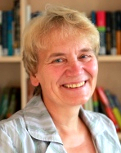People
The team working on the GEMS project consists of members from the University of Rostock and the Technische Universität Dresden.
Raimund Dachselt

Since April 2012, Prof. Raimund Dachselt has been a Full Professor of Computer Science and head of the Interactive Media Lab Dresden at the Technische Universität Dresden, Germany. His research interests are natural human computer interaction (HCI), interactive information visualization, and Mixed Reality interaction. He worked extensively in the area of interactive surfaces from smartwatches over tablets and tabletops to wall-sized displays (also combined in multi-display environments) and combined interaction modalities (e.g., multi-touch and pen, tangible displays, gaze-supported interaction, body gestures). He and his team made pioneering contributions to the field of interactive data visualization beyond the desktop including solutions for mobile devices, ultra-large displays, multi-device environments, Augmented Reality and other Immersive Analytics approaches. Significant contributions in the area of physical computing have recently extended the technology spectrum far beyond standard devices.
Heidrun Schumann

Prof. Heidrun Schumann is a professor at the Institute for Computer Science at the University of Rostock, Germany, where she heads the Computer Graphics Research Group. Her research and teaching activities cover a number of topics related to computer graphics, particularly including information visualization, visual analytics, and rendering. More specifically, she is interested in the visualization of structures and multivariate data in space and time, in the design of scalable visual interfaces, and in terrain rendering techniques. Her current research projects are funded by public agencies and industry and span from fundamental research (e.g., scalable visualization methods and visual interfaces for smart environments) to applied research (e.g., computer graphics in the cockpit and visualization of bio-medical data). Heidrun is co-author of the first German textbook on visualization.
Christian Tominski

Christian Tominski is a scientist at the Chair of Visual Analytics at the University of Rostock, Germany. He received doctoral (Dr.-Ing.) and post-doctoral (Dr.-Ing. habil.) degrees in 2006 and 2015, respectively. In 2021, he was granted the title of professor (apl. Prof.) for human-data interaction. His main research interests are in visualization of and interaction with data. He is particularly interested in effective and efficient techniques for interactively exploring and editing complex data. Christian has published numerous papers on new visualization and interaction techniques for multivariate data, temporal data, geo-spatial data, and graphs. He co-authored three books, including a book on the visualization of time-oriented data in 2011, a book focusing on interaction for visualization in 2015, and a more general book about interactive visual data analysis in 2020. Christian has developed several visual analytics systems and tools, including the LandVis system for spatio-temporal health data, the VisAxes tool for time-oriented data, and the CGV system for coordinated graph visualization.
Tom Horak

Tom Horak joined the Interactive Media Lab as a research associate / Ph.D. student in February 2016 and was since then focusing on bringing novel interaction techniques to information visualizations on modern devices. Specifically, his research interest was on forming so-called device ecologies with multiple co-located devices and to facilitate data analysis with them. This research formed his PhD thesis, which he successfully defended on July 7, 2021.
Philip Berger

Philip Berger is a scientist at the Institute for Visual & Analytic Computing at the University of Rostock, Germany. He joined the chair of Visual Analytics as research assistant / Ph.D. student in July 2017 and was since then focusing on the visual analysis of multivariate graphs. In particular, his research focuses on novel techniques for integrating visual exploration and direct manipulation (editing) of the structure and attributes of multivariate graphs.